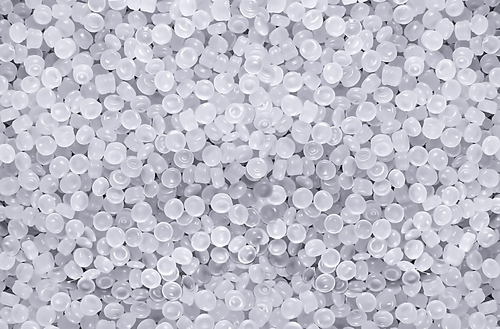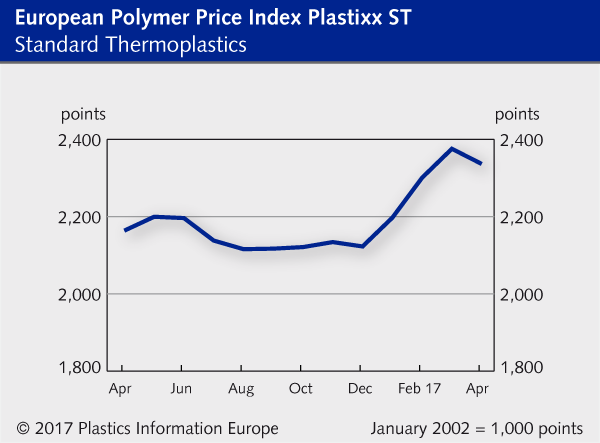
Latest Polymer Price Reports – April 2017
The latest polymer price reports and charts have been released by Plastics Information Europe (PIE).
Standard Thermoplastics April 2017: Split demand / Sudden buyers’ restraint after Easter / PE already declining, PP dampened / PS plunges after SM / Weakening trend in May
PE: In April, the about-turn in the factors responsible for price movements in the global oil and downstream markets did not go unnoticed by European PE buyers. Whereas most grades were still under upward pressure at the beginning of the month, the picture changed significantly over the Easter holidays. The turnaround also meant that buyers’ restraint grew significantly in the second half of the month, as they purchased only what they absolutely needed. With low-pressure grades in particular, this has already led to small initial price cuts, while LD producers managed to hang on to a rollover until the end of the month. Apart from the LLD injection moulding grades, which are in very short supply, the only other exceptions were the pipe grades. Here, with the building season really picking up speed, prices moved up slightly. The upward momentum that previously dominated this year has come to an abrupt halt. Despite the renewed rollover in the ethylene reference price the signs for May are pointing down. The only real exceptions are the types used in the building sector – especially the pipe grades – as well as certain LLD injection moulding grades that are still on the tight side.
PP: In the first half of April, PP producers were able to achieve slight margin gains, but the situation clearly reversed after the Easter holidays. With feedstocks pointing downward, converters took a more cautious approach and ordered only what was immediately needed. For polymer products that faced import competition, suppliers could not even pass on their higher costs. Copo buyers, who are more dependent on European product, could at least hold producers’ margin improvements to a minimum. Compounds also saw only minimal upward pressure, in particular those indexed to standard PP. In May, producers will be able to raise prices only in their dreams. Their dreams could turn to nightmares moreover, as despite the rollover of the European propylene contract, notations for basic grades could even begin to deteriorate slightly. Here, the global downward trend will make its influence felt. By the reverse token, prices for copo grades and compounds could stabilise somewhat.
PVC: As expected, the European PVC suppliers took advantage of the ongoing maintenance season to further boost their margins. Against the backdrop of a rollover for ethylene, they succeeded in pushing through moderate price increases. Their eager ambitions were kept in check somewhat, however, by rising quantities of imports – triggered by the high notations in Europe. At the same time, rigid PVC blends registered a further disproportionate increase following dramatic developments for the key additive titanium dioxide. Prices for rigid blends are now even considerably above those for flexible blends. Meanwhile, PVC pastes hovered resolutely at a high altitude, way above the suspension PVC that remained on the flat terrain beneath them. The C2 notation is continuing unchanged into May. Stable to slightly firming prices are to be expected for the base material. Flexible compounds and PVC pastes will essentially follow this trend. In the case of rigid PVC materials, by contrast, the titanium dioxide thrust seems set to continue unabated. Disproportionate increases can be expected here.
Styrenics: The wheel has turned. After the boom of the previous months, the SM reference contract’s significant decrease by EUR 275/t has initiated the anticipated price correction in April. Across the board, styrenics could not maintain their previous record levels anymore and had to take significant losses. Just as increases were not transferred in full during the price rally, the current price change was not transferred in full either. ABS was additionally encumbered by the development of butadiene (rollover) and ACN (increase). Earlier, falling spot market prices had already pointed at another significant decrease of the SM reference contract in May, which let many processors trim their orders in the second half of April to minimum volumes. The sheer amount of the SM reduction still surprised many players. Just as in April, the May cost reduction of EUR 245/t will probably not be transferred in full, but buyers can again expect three-digit price reductions for all styrenics – including for ABS, whose composite butadiene also plummeted by EUR 225/t.
PET: The European PET producers’ hopes of being able to benefit further from the upcurrent of the previous months were shattered in April 2017 when refreshing gusts blew in from the Far East. Notations in the polyester chain had fallen sharply there at the end of March and, as if by magic, import offerings at particularly favourable conditions landed on the European purchasers’ doormats. At the same time, the cost of feedstocks for production in Europe fell. Purchasers rapidly switched to exercising pronounced restraint. Suppliers were thus left with no other choice but to grant discounts. And they did not get by with just passing on the reduction in costs. Instead, they had to relinquish the slight improvements they had achieved in their margins over the past few months again. Regrind remained firm at mid-month, still awaiting on post-Easter developments. The price drop for primary material would appear extensive enough to trigger reductions here too in the near future. In the meantime, while the Asian polyester chains have calmed down again, a weakness in the base material oil would seem imminent. Imports are still being offered at increasingly favourable conditions, with prices moving below four digits in some cases. Seasonal business for bottles should pick up in May, with demand gaining momentum. Buyers are still hesitant, however, in light of the continuing downwards trend. From the current standpoint, it would seem that at least moderate reductions could be on the cards.
Engineering Thermoplastics April 2017: Wave of increases rolls on through the market / Rises smaller than in March / Market tending tight / Some delivery times lengthen significantly / Effects could last into May
As expected, prices for engineering thermoplastics in Europe continued to increase throughout April. As the impulses from the feedstock markets declined, there was a considerable amount of catching-up to do on the open market following the high quarterly agreements. In addition, availability was particularly tight with many types. Delivery times lengthened considerably and, with PC for example, are now as long as 20 weeks. Polyamides also tended ever tighter. In the case of PMMA, allocations have become the order of the day. At the same time, many buyers were nervously on the hunt for extra material because the end markets were ordering at a lively rate. The commodity-related PP compounds, on the other hand, rose only marginally in line with the C3 reference price. ABS reflected the easing of the feedstock situation and dropped from its record level for the first time, often by a triple-digit amount. Prices are nevertheless still very high.
The situation remains especially tense with PA and PMMA. Here, substantial increases are to be expected again in May, which can certainly run into triple digits. With the other types covered by this report, there is a latent upward pressure, but this could well be dampened by the falling tendency in feedstock notations. The flurry on the demand side is also likely to ease slightly because automotive demand in particular is gradually returning to its normal level.
For more than 34 years, PIE has been an invaluable source of information for European plastics industry decision makers – a quick, yet in-depth look at the development of plastics markets and polymer prices. Available online 24/7 and as a printed newsletter twice a month. To read the entire report, go to www.pieweb.com and sign up for a 48-hour free trial!







